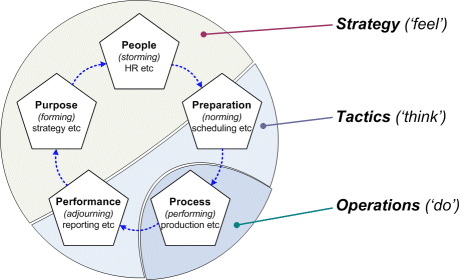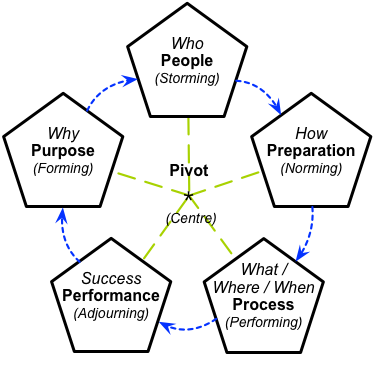An inventory, sorted
I’ll try for another way to sort and describe the current state of that stack of tools and methods that I’ve developed over the past decade or so, to guide business change and transformation, and that, for various reasons, I’d nicknamed the ‘bucket-list’. As we’re at last launching our Patreon page in the next couple of days, this should help make it clearer what exactly it is that we’re aiming to fund via that Patreon.
I’m moving more to centring the whole tool-suite around the Five Elements frame:
The reason for using that as the centre is because it’s a consistent method for change-guidance and change-governance that works in the same way for every type of scope, scale and context – such as described in depth, in this post, about a year ago.
One trivial complication is that although it’s called ‘Five Elements’, there are actually six categories into which we might classify each tool. The sixth – or, arguably, the first – is the centre-point or pivot around which the Five Elements cycle will revolve:
Anyway, here’s that list of tools, in Five Elements order, with suggested keywords that point to each of the tools, and pointers to various sources that describe them.
(Each tool is listed in detail ‘in’ only one domain. In the occasional case where a given tool is used often in more than one domain, I’ve added references in the respective ‘other’ domains back to the ‘master’-description in the domain where that tool is most frequently used.)
Pivot:
- primary-tools:
- Five Elements method and model for change-guidance
[keywords: change, governance, how-to, process, project, strategy-to-execution]
(described in various blog-posts and in the books SEMPER and SCORE and Real Enterprise-Architecture) - SCAN frame for sensemaking and complexity-mapping
[keywords: complexity, decision-making, education, mapping, real-time action, sensemaking, training, time (future-to-now)]
(described in many blog-posts, the SCAN ebook, the slidedecks ‘The Dung Beetle’s Tale‘ and ‘Same and Different‘, and the in-progress SCAN Sketchbook) - SEMPER effectiveness diagnostic
[keywords: competence, effectiveness, options (for change), politics, priorities, responsibility, ‘rights’]
(described in book SEMPER and SCORE; also as a standalone web-app)
- Five Elements method and model for change-guidance
- support-tools:
- Maturity-Model to guide prioritisation of tasks
[keywords: competence, complexity, maturity]
(described in various blog-posts, in the book Doing Enterprise-Architecture, and in the slidedeck ‘Stepping-stones of enterprise-architecture‘) - Mythquake scale and diagnostic to identify factors in small- to big-picture change
[keywords: change, disruption, politics, risk, worldview]
(described in a blog-post series (content for an incomplete book) and other posts) - Strategic metamethod for high-level architecture (‘what I do and how I do it’)
[keywords: change, disruption, exploration, investigation, strategy]
(described in various blog–posts)
- Maturity-Model to guide prioritisation of tasks
Purpose:
- primary-tools:
- SCAN frame: see Pivot (centre)
- Visioning for strategic mapping (development of vision, values, effectiveness-criteria)
[keywords: effectiveness, purpose, values, vision, why]
(described in the slidedeck ‘Vision, Role, Mission, Goal‘)
- support-tools:
- Effectiveness-mapping frame (derive effectiveness-criteria from values)
[keywords: effectiveness, efficiency, quality]
(described in various blog–posts, in the slidedeck ‘What is effectiveness?‘, and in the book Real Enterprise Architecture)
- Effectiveness-mapping frame (derive effectiveness-criteria from values)
People:
- primary-tools:
- Holomap for stakeholder/interaction mapping
[keywords: anticlient, context, relationship, stakeholder, who]
(described in various blog–posts) - Power-model as used in SEMPER and other tools
[keywords: blame, power, responsibility, ‘rights’]
(described in various blog-posts and in books SEMPER and SCORE and Power and Response-ability)
- Holomap for stakeholder/interaction mapping
- support-tools:
- 5+5+1 leadership model for situational-leadership (use with Five Elements)
[keywords: leadership]
(described in one blog-post and in the book SEMPER and SCORE) - Methods / Mechanics / Approaches skills-map (descriptor for skills-development)
[keywords: education, skills, training]
(described in various blog–posts) - NOTES (narrative-oriented mapping and transformation): see Preparation
- SEMPER diagnostic as diagnostic/metric for power-issues: see Pivot (centre)
- Seven Sins discipline-management model (as error-prevention): see Process
- Skills Labyrinth skills-learning map (diagnostic/exercise for skills-development)
[keywords: collaboration, education, learning, skills, training]
(described in various blog-posts) - Swamp-metaphor model (as diagnostic for mindsets/value-systems): see Process
- 5+5+1 leadership model for situational-leadership (use with Five Elements)
Preparation:
- primary-tools:
- Enterprise Canvas (‘Enterprise Service Canvas’) suite for service-oriented modelling (service-structure, relations, flows)
[keywords: capabilities, deliverable, flow/exchange, how/what (as structure), modelling, quality, service, structure]
(described in many blog-posts, in the books The Service-Oriented Enterprise and Mapping the Enterprise, and the Enterprise Canvas ebook, and in the slidedeck ‘Bridging Enterprise-Architecture and Systems-Thinking‘) - NOTES narrative-oriented mapping and transformation (guidance on change-process)
[keywords: anticlient, change, completeness, narrative, stakeholder, story, transformation]
(described in various blog-posts, in the book The Enterprise As Story, and in the slidedeck ‘Staging the story‘) - SCORE frame for strategy-development
[keywords: capabilities, challenge, mapping, opportunity, options, priorities, risk, strategy-to-execution]
(described in various blog-posts, in the book SEMPER and SCORE, and the slidedeck ‘Introduction to SCORE‘)
- Enterprise Canvas (‘Enterprise Service Canvas’) suite for service-oriented modelling (service-structure, relations, flows)
- support-tools:
- Context-space mapping (for strategic/tactical sensemaking): see Process
- Effectiveness-mapping (for governance, and use with SCORE mapping): see Purpose
- Holomap (use with Enterprise Canvas): see Purpose
- Extended-Zachman frame (Zachman replacement for whole-enterprise architecture) (usually with Enterprise Canvas)
[keywords: asset, composition, strategy-to-execution, structure, what-is (as structure)]
(described in the books Real Enterprise-Architecture and Bridging the Silos, and the associated reference-sheet) - Backbone and Edge framework for metagovernance (governance of lifecycles and change)
[keywords: change, complexity, governance, lifecycle, time]
(described in various blog–posts and in the slidedeck ‘Backbone and edge‘) - Mythquake model as diagnostic/metric for risk-level: see Pivot (centre)
- Seven Sins discipline-management model: see Process
- Swamp-metaphor model: see Process
- Tetradian context-dimensions model (‘asset-dimensions’) (usually with Enterprise Canvas)
[keywords: asset, deliverable, service, structure, what-is (as structure)]
(described in various blog–posts, and implicit as underlying structure for book Power and Response-ability) - The ‘This’ game for service-modelling (usually with/as Enterprise Canvas)
[keywords: exploration, investigation, modelling, service]
(described in various blog–posts and in the slidedeck ‘Innovation – find the gap!‘)
Process:
- support-tools:
- Context-space mapping for tactical/operational sensemaking
[keywords: complexity, decision-making, mapping, operations, problem/solution, sensemaking, strategy, tactics]
(described in various blog-posts and in the book Everyday Enterprise-Architecture) - Maturity-model as diagnostic for action-options: see Pivot (centre)
- Seven Sins discipline-management model (as error-diagnostic)
[keywords: decision-making, error (cognitive-dysfunction), sensemaking, thinking-mistakes]
(described in a series of blog-posts) - SMDA loop sensemaking/action model (real-time variant of Five Elements)
[keywords: action, decision-making, how-to, process, real-time action, sensemaking]
(described in one blogpost) - Swamp-metaphor model for guidance of sensemaking (related to but distinct from SCAN)
[keywords: decision-making, error, paradigm, sensemaking, skills, worldview]
(described in various blog–posts and in the book Inventing Reality) - The ‘This’ game (as quick diagnostic for service-issues): see Preparation
- Context-space mapping for tactical/operational sensemaking
Performance:
- primary-tools:
- Extended-After Action Review (process to support continual-improvement)
[keywords: collaboration, completion, continual-improvement, skills]
(described in various blog-posts and in the slidedeck ‘Whole-enterprise architecture‘)
- Extended-After Action Review (process to support continual-improvement)
- support-tools:
- Effectiveness-mapping (review-criteria for continual-improvement): see Purpose
- Seven Sins discipline-management model (as error-review): see Process
Miscellaneous:
- Methods for ‘Really-Big-Picture Enterprise-Architecture’ (‘RBPEA’) (application of any/all elements at large scope/scale)
[keywords: big-picture, complexity, exploration, global, investigation, large-scale]
(described in many blog-posts) - Revised-ADM eight-phase architecture method (TOGAF-ADM replacement for whole-enterprise architecture)
[keywords: change, how-to, process, TOGAF]
(described in the books Everyday Enterprise Architecture and Bridging the Silos and the associated reference-sheet
Using the Five Element sequence, and nesting of Five Elements cycle, tools are often linked together in chains, to form a distinct step-by-step process. You’ll see one example of this kind of ‘chaining’ of tools in the recent slidedeck for the IASA/ICS workshop on ‘Tracking value in the enterprise‘, with ten steps from existing concepts of value, to identifying enterprise-stakeholders, to modelling value-flow, and on to mapping balance of value between investors, beneficiaries and all other types of stakeholders.
And of course you can link into this structure any other tools that you currently use, to create your own tools-chaining under the same consistent overall guidance-structure. The whole idea is that this is inclusive, and ‘plays nicely’ with whatever tools anyone might need to use. There’s more detail on that in the posts ‘4: Content‘ and ‘5: Practices and toolsets‘ in the series on ‘Towards a whole-enterprise architecture standard‘.
Hope this makes sense? – do let me know, anyway.


Leave a Reply